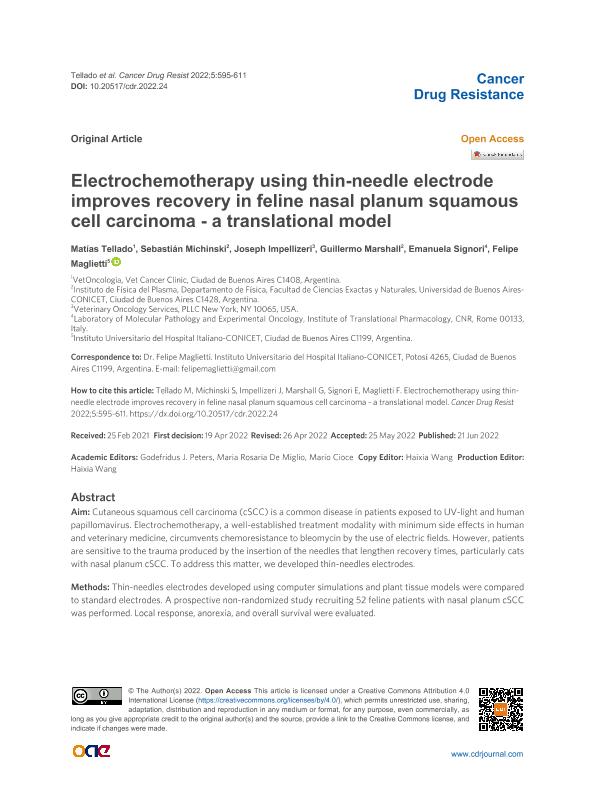Mostrar el registro sencillo del ítem
dc.contributor.author
Tellado, Matías Nicolás

dc.contributor.author
Michinski, Sebastián Diego

dc.contributor.author
Impellizeri, Joseph
dc.contributor.author
Marshall, Guillermo Ricardo

dc.contributor.author
Signori, Emanuela

dc.contributor.author
Maglietti, Felipe Horacio

dc.date.available
2023-07-06T13:24:14Z
dc.date.issued
2022-06
dc.identifier.citation
Tellado, Matías Nicolás; Michinski, Sebastián Diego; Impellizeri, Joseph; Marshall, Guillermo Ricardo; Signori, Emanuela; et al.; Electrochemotherapy using thin-needle electrode improves recovery in feline nasal planum squamous cell carcinoma - a translational model; OAE Publishing Inc.; Cancer Drug Resistance; 5; 3; 6-2022; 595-611
dc.identifier.uri
http://hdl.handle.net/11336/202602
dc.description.abstract
Aim: Cutaneous squamous cell carcinoma (cSCC) is a common disease in patients exposed to UV-light and human papillomavirus. Electrochemotherapy, a well-established treatment modality with minimum side effects in human and veterinary medicine, circumvents chemoresistance to bleomycin by the use of electric fields. However, patients are sensitive to the trauma produced by the insertion of the needles that lengthen recovery times, particularly cats with nasal planum cSCC. To address this matter, we developed thin-needles electrodes. Methods: Thin-needles electrodes developed using computer simulations and plant tissue models were compared to standard electrodes. A prospective non-randomized study recruiting 52 feline patients with nasal planum cSCC was performed. Local response, anorexia, and overall survival were evaluated. Results: Computer simulations and plant model experiments showed satisfactory results with both electrodes. The patients treated with the thin-needle electrode obtained similar local response rates compared to the standard group, OR 97.3% vs. 80%, respectively (P < 0.067). Most patients in the thin-needle group resumed eating in less than 48 h, as the anorexia was significantly lower (P < 0.0001). Using the standard electrode, most patients took 3 to 5 days to resume normal feeding. The electric current circulating in the standard electrode was 44% higher, contributing to a longer duration of anorexia due to tissue damage. The overall survival in both groups was similar. Conclusion: Electrochemotherapy using thin-needle electrodes provides equivalent local response rates and overall survival compared with standard electrodes but significantly reduced return to appetite after the treatment. These results may be useful in the development of new electrodes for human patients.
dc.format
application/pdf
dc.language.iso
eng
dc.publisher
OAE Publishing Inc.
dc.rights
info:eu-repo/semantics/openAccess
dc.rights.uri
https://creativecommons.org/licenses/by/2.5/ar/
dc.subject
CANCER
dc.subject
CAT
dc.subject
CSCC
dc.subject
ECT
dc.subject
ELECTROPORATION
dc.subject
NOSE
dc.subject
SCC
dc.subject
TUMOR
dc.subject.classification
Oncología

dc.subject.classification
Medicina Clínica

dc.subject.classification
CIENCIAS MÉDICAS Y DE LA SALUD

dc.subject.classification
Otras Ciencias Veterinarias

dc.subject.classification
Ciencias Veterinarias

dc.subject.classification
CIENCIAS AGRÍCOLAS

dc.title
Electrochemotherapy using thin-needle electrode improves recovery in feline nasal planum squamous cell carcinoma - a translational model
dc.type
info:eu-repo/semantics/article
dc.type
info:ar-repo/semantics/artículo
dc.type
info:eu-repo/semantics/publishedVersion
dc.date.updated
2023-07-05T10:56:28Z
dc.identifier.eissn
2578-532X
dc.journal.volume
5
dc.journal.number
3
dc.journal.pagination
595-611
dc.journal.pais
Estados Unidos

dc.journal.ciudad
Alhambra
dc.description.fil
Fil: Tellado, Matías Nicolás. Universidad de Buenos Aires. Facultad de Ciencias Veterinarias. Área de Química Biológica; Argentina. Vet Cancer Clinic; Argentina
dc.description.fil
Fil: Michinski, Sebastián Diego. Consejo Nacional de Investigaciones Científicas y Técnicas. Oficina de Coordinación Administrativa Ciudad Universitaria. Instituto de Física del Plasma. Universidad de Buenos Aires. Facultad de Ciencias Exactas y Naturales. Instituto de Física del Plasma; Argentina
dc.description.fil
Fil: Impellizeri, Joseph. Veterinary Oncology Services; Estados Unidos
dc.description.fil
Fil: Marshall, Guillermo Ricardo. Consejo Nacional de Investigaciones Científicas y Técnicas. Oficina de Coordinación Administrativa Ciudad Universitaria. Instituto de Física del Plasma. Universidad de Buenos Aires. Facultad de Ciencias Exactas y Naturales. Instituto de Física del Plasma; Argentina
dc.description.fil
Fil: Signori, Emanuela. Consiglio Nazionale Delle Ricerche. Departimento Di Medicina. Instituto Di Farmacología Traslazionale; Italia
dc.description.fil
Fil: Maglietti, Felipe Horacio. Consejo Nacional de Investigaciones Científicas y Técnicas; Argentina. Hospital Italiano; Argentina
dc.journal.title
Cancer Drug Resistance
dc.relation.alternativeid
info:eu-repo/semantics/altIdentifier/url/https://cdrjournal.com/article/view/4900
dc.relation.alternativeid
info:eu-repo/semantics/altIdentifier/doi/http://dx.doi.org/10.20517/cdr.2022.24
Archivos asociados
